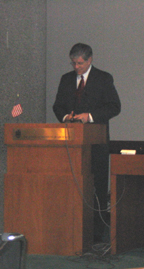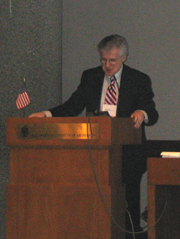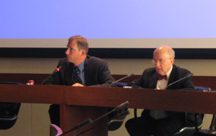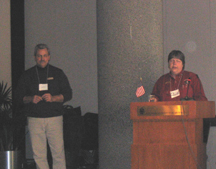Task Force Winter 2005 Meeting
The Heritage Emergency National Task Force marked its tenth anniversary with a meeting in Washington, DC. The meeting convened at the American Institute of Architects in the same room as the Summit on Emergency Response in December 1994, which led to the formation of the Task Force.
 |
David Maurstad, Acting Director for Mitigation, Federal Emergency Management Agency |
Heritage Preservation President Larry Reger opened the meeting and introduced the first speaker, David Maurstad, Acting Director for Mitigation, Federal Emergency Management Agency. Mr. Maurstad talked about his experiences with preservation and the importance of the work the Task Force is doing. He noted that most disasters don’t involve FEMA; the real action is at the community level, and local institutions need help in developing plans and procedures to protect their community’s treasures. He said that FEMA is proud of its participation in the Task Force and that he is looking forward to his and FEMA’s continued involvement.
Next, James Dinegar, Chief Operating Officer of the AIA, spoke about AIA’s great interest in preserving history and praised the Task Force’s work to integrate cultural resources into emergency planning considerations. “What you do is very important to AIA,” he said, adding that he planned to be a more active participant in the Task Force.
 |
Tom Mallon, Director of the Division of Preservation and Access, National Endowment for the Humanities |
Heritage Preservation Chairperson Debra Hess Norris introduced Tom Mallon, the new Director of the Division of Preservation and Access, National Endowment for the Humanities. Dr. Mallon, an author and historian, thanked the Task Force for developing the Emergency Response and Salvage Wheel, which is used in many of the libraries, archives, and historical societies he has worked in. He spoke of NEH’s long history of supporting disaster preparedness and response and said that, as someone interested in history, he has a personal stake in protecting historic collections and records. He then announced that NEH has awarded Heritage Preservation a $210,180 grant to support development, production, and dissemination of the Field Guide to Readiness and Response, which will consist of a print volume and companion DVD. “We look forward to seeing the product of this grant,” Mallon said.
John Ketchum, FEMA’s Federal Preservation Officer, talked about the original summit meeting and said he remembered the sense of excitement the first time the emergency response and cultural communities came together to talk. He recalled Dick Krimm’s advice to take on commitments with realistic goals and come up with solid projects that the Task Force members could focus on together. Mr. Ketchum said that the last decade has borne out that advice.
Mr. Reger acknowledged two new members of the Task Force—the National Commission on Libraries and Information Science, represented by Trudi Hahn, and the National Historical Publications and Records Commission, represented by Richard Cameron. Attendees all introduced themselves. Mr. Reger noted those who had also been at the original summit meeting.
 |
John Ketchum, FEMA’s Federal Preservation Officer, and Larry Reger, President, Heritage Preservation |
Mr. Ketchum gave an update on FEMA’s activities, beginning with the Pre-Disaster Mitigation Grant program. He then talked about the how-to guide FEMA is releasing this summer, part of a series that helps local and state emergency managers go through a step-by-step disaster planning process for communities. It encourages a focus on historic properties and links them to the economic well-being of the community as a source of heritage tourism. The guide concentrates on the built environment, but cultural institutions and collections are included. Steps include identifying resources and creating a planning team; determining which historic properties are priorities; evaluating hazard mitigation activities with a cost-benefit analysis; and developing and implementing hazard mitigation plans. Mr. Ketchum said he hoped Task Force members would help get the word out about the guide when it is released.
Training to improve coordination between cultural stewards and first responders is also a FEMA focus, Mr. Ketchum noted. A focus group will be held at the Emergency Management Institute in June to outline a curriculum to improve coordination and communication between the two groups. He noted the tie-in with the Task Force’s Alliance for Response project and talked about its successful follow-up activities.
Mr. Ketchum also mentioned that Heritage Preservation, FEMA, and NEA are updating and expanding Resources for Recovery: Post-Disaster Aid for Cultural Institutions. The new version will include planning and mitigation resources as well. Mr. Ketchum said this project is an example of a coalition’s work to disseminate information to a wide audience.
 |
Pam West, Director, Museum Resource Center, and Robert Sonderman, Senior Staff Archeologist, National Park Service |
Pam West, Director, Museum Resource Center, and Robert Sonderman, Senior Staff Archeologist, National Park Service, gave a presentation on the NPS Museum Emergency Response Team’s work after Hurricanes Isabel and Ivan. Their tales of stabilizing and evacuating collections despite water moccasins, spiders, toxic mold, and hungry raccoons brought home the importance of proper design and planning for collections storage and display areas as well as the hard work necessary to rescue water-damaged collections. The Museum Emergency Response Team was formed after Hurricane Isabel devastated the Jamestown visitors’ center and the finest collection of 17th-century glass and ceramics in the country. They were trained in how the federal Incident Command System works. Every team member has a Ready Bag—including necessities like gloves, a mask, and the Emergency Response and Salvage Wheel—and can be ready to respond to a disaster on short notice. Hurricane Ivan hit the Gulf Islands National Seashore with a 50-foot wave three weeks after the team finished their training. The team was not able to reach the collections for nine days after the storm because of safety concerns, and then had to evacuate the island before Tropical Storm Matthew moved in. Challenges included finding supplies and transporting them to the island by boat, since all bridges were washed out, as well as setting up temporary housing.
Ann Russell, Executive Director of the Northeast Document Conservation Center, talked about dPlan, an online disaster planning tool for Massachusetts libraries. NEDCC hopes to expand the program beyond Massachusetts.
 |
Jane Long, Director of the Heritage Emergency National Task Force (at right) |
Jane Long, Director of the Heritage Emergency National Task Force, talked in a little more detail about the Field Guide to be developed with the NEH grant. It will be an expanded version of the information on the Emergency Response and Salvage Wheel, with step-by-step instructions illustrated on the DVD. It will also address risk assessment, health and safety, and other concerns.
Mr. Ketchum proposed forming a working group on historic properties and the challenges they present in responding to disasters. Largely because of its statutory obligations, FEMA deals more with buildings and sites than collections. The agency would be happy to host an initial meeting, and he invited interested Task Force members to contact him.
Mr. Reger noted that working groups on special interests are in the Task Force tradition, and he suggested creating one on information distribution following hurricanes and other major events. Jane Long described the steps that Heritage Preservation took following last fall’s hurricanes and invited Task Force members to help improve communications with both institutions and the public. One idea is to distribute salvage advice on photographs and other heirlooms through local libraries and museums.
On the international front, Mr. Reger noted that a summary of damage to cultural heritage from the Asian Tsunami had been released by ICOMOS and was available at the meeting. A list-serv hosted by the University of Chicago was cited as one of the best sources for current information on the recovery and protection of cultural property in Iraq. Several members discussed Blue Shield and mentioned its efforts to identify cultural heritage targets of terrorism in Europe. Diane van der Reyden said that the Library of Congress and several Ivy League universities are interested in undertaking a similar terrorism risk assessment in the United States. The issue of lobbying the U.S. Senate to ratify the Hague Convention was raised in the context of Blue Shield. Mr. Reger noted that such action is illegal for federal agencies on the Task Force. The Heritage Emergency National Task Force itself cannot lobby, but its non-federal member organizations are free to do so on their own.
Tom Clareson of OCLC commented that needs assessments show even in good states, only half of institutions have disaster plans and that many have expressed interest in Alliance for Response. He said that there was plenty of work for the Task Force for the next 10 or 20 years.
Mr. Ketchum remarked that the meeting had been very educational and noted that the Task Force will meet again later in 2005. He then adjourned the meeting.

